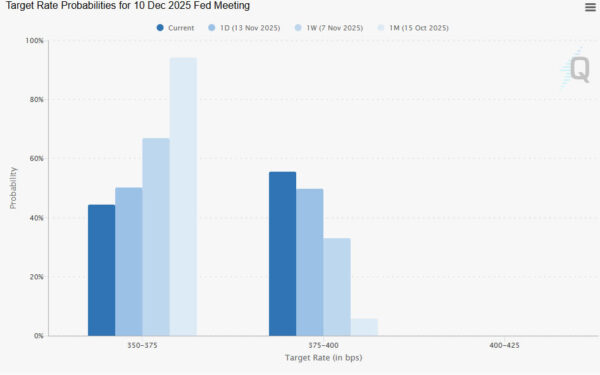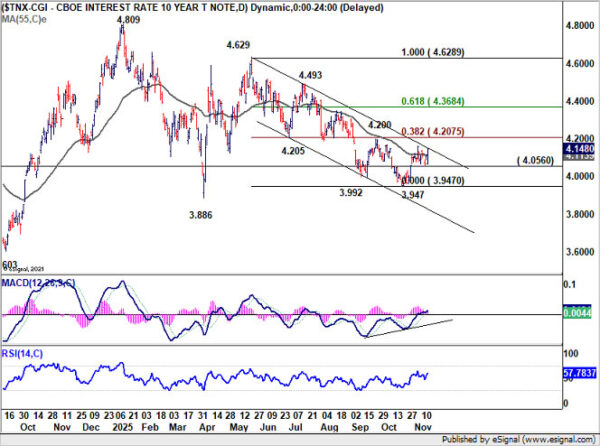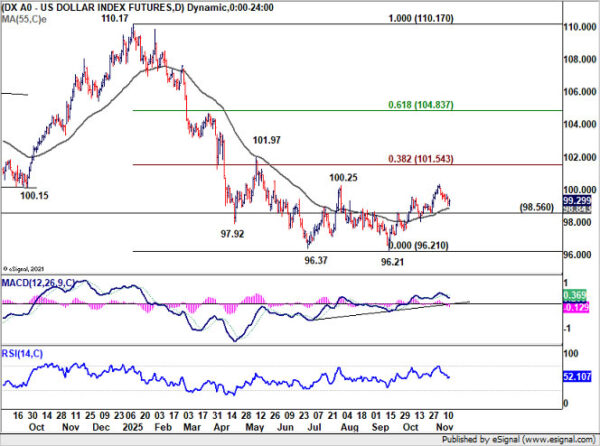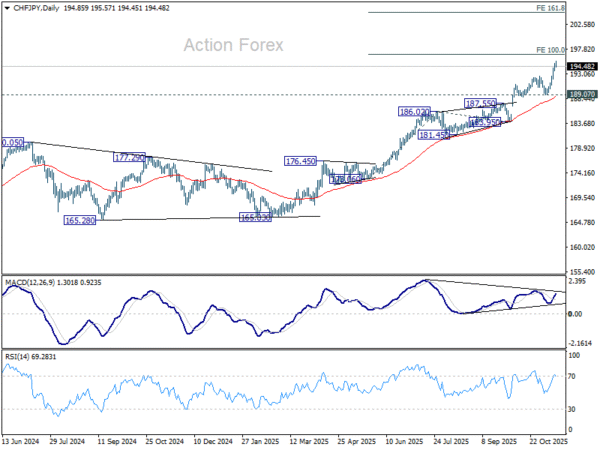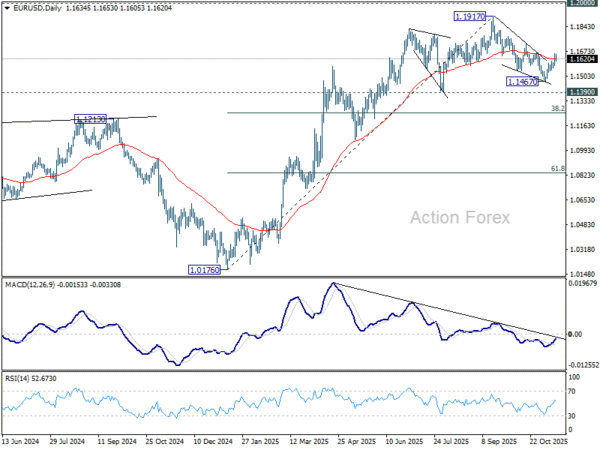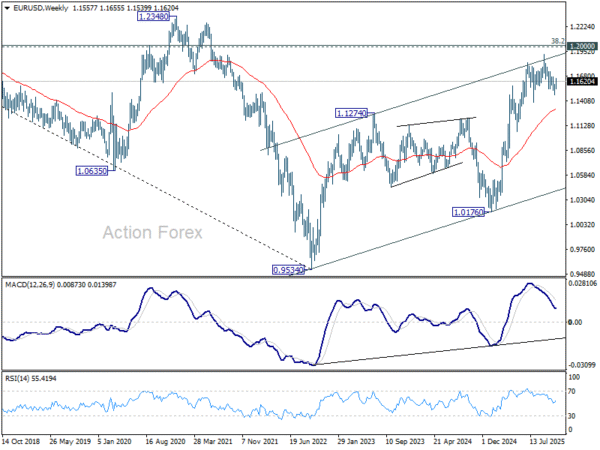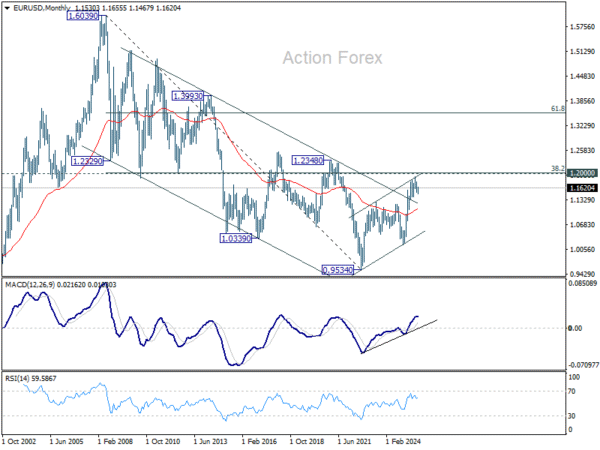Investors Step Back From US Assets Ahead of Data Flood – Action Forex
Last week delivered what should have been a moment of relief for global markets: the US finally ended its historic government shutdown, clearing the way for normal economic data flow to resume. Yet instead of sparking a rally, the reopening brought little comfort.
U.S. assets struggled across the board. Equities came under pressure as investors reassessed the risks around Fed policy direction and stretched valuations in key growth sectors. Yields moved higher but offered no support to Dollar, which weakened broadly despite fading expectations of near-term Fed easing. Even the traditional safe-haven flows that typically favor the greenback failed to materialize in a meaningful way.
Currency markets delivered their own twist. Yen, often the first beneficiary of a risk-off wave, ended the week as the worst performer as traders pushed out expectations for a BoJ rate hike. Sterling suffered as well, pressured by weak economic data and growing conviction that the BoE would cut rates in December.
By contrast, Swiss Franc surged on a mix of safe-haven demand and positive trade developments. Australian and New Zealand Dollars found some early support but struggled to extend gains as sentiment darkened. Euro and Canadian Dollar sat in the middle of the pack.
Is ‘Sell America’ Returning, or Just a Pause Before the Data Storm?
The past week delivered an unusual alignment across U.S. assets: stocks, Treasuries, and Dollar all came under pressure at the same time. That pattern immediately drew comparisons to April, when markets reacted violently to President Donald Trump’s “Liberation Day” announcement, triggering the now-famous “Sell America” trade. While last week’s moves were nowhere near that magnitude, the directional similarity was difficult to ignore.
Still, calling it a revival of the same theme may be premature. Market positioning seems far more cautious than actively bearish. The historic government shutdown kept investors blind to key economic signals for weeks. With the data blackout now lifted, traders appear reluctant to make big commitments until a clearer macro picture emerges. The pullback in U.S. assets may simply reflect a desire to step aside before the next wave of information hits.
The coming week could prove decisive. With the government now reopened, the pipeline of U.S. economic releases is about to restart — and after several weeks of silence, the impact could be amplified. Volatility, which has softened noticeably during the shutdown, is likely to climb as markets digest a heavy flow of indicators that will reset expectations for both growth and inflation.
What those data reveal will determine whether last week’s moves were a temporary misalignment or the early stages of a more structural shift. A resilient economy with stable job growth could revive confidence in U.S. assets. A deteriorating backdrop could force a deeper repricing. Anything in between would keep traders directionally cautious but tactically reactive.
For now, the only certainty is uncertainty itself. Markets briefly lost their footing last week, and the synchronized weakness across U.S. stocks, bonds, and Dollar has raised legitimate questions about investor conviction. Whether that hesitation evolves into a broader “Sell America” theme could depend entirely on what the long-delayed data now reveal.
Fed Cut Odds Crumble, Yields Rebound
Expectations for a December Fed rate cut shifted sharply last week after a set of remarks from FOMC officials signaled that easing is far from guaranteed. What had looked like a near-certainty just a month ago is now a coin toss: market odds for a December cut have fallen to 44.4%, down from 66.9% a week earlier and 94.2% a month ago.
Some economists reinforced that view by noting that GDP prior to the shutdown was tracking at 3.5% to 4%, a pace more consistent with overheating than with urgency for additional stimulus. Financial conditions also remain unusually easy, leaving little justification for further policy accommodation. Lowering funding costs for banks at this stage risks could do more harm than good by reigniting price pressures just as progress toward 2% inflation remains uneven.
The repricing in expectations helped drive a meaningful move in Treasuries. 10-year yield jumped sharply on Friday, closing at 4.148. But for now, the rebound from 3.947 short term bottom is still viewed as a corrective move within the broader decline from 4.629.
Technically, resistance near 4.200 should form a formidable cap, with 4.205 support turned resistance and 38.2% retracement of 4.629 to 3.947 at 4.207. Break of 4.056 support will suggest that the corrective bounce has completed, and bring retest of 3.947 low.
However, decisive break above 4.200 would suggest the decline from 4.629 has run its course, and open way to 61.8% retracement at 4.368.
Tech Jitters Persist, But Dip Buyers Defend Key Support
US equities spent latter part of last week struggling under the weight of shifting Fed expectations and the re-emergence of AI valuation concerns. Yet, just as in the prior week, buyers stepped in late on Friday, hinting that dip-buying appetite has not fully disappeared. NASDAQ closed at 22,900.58 after plunging to 22,436.79, a notable recovery given the earlier capitulation.
Technically, NASDAQ is still holding the line where it matters most. It remains above its 55 Day EMA (now at 22,683.37), and more importantly, above key structural support at 22,193.07. As long as these levels hold, the broader uptrend remains intact, and the path toward a fresh record high stays open.
However, D MACD continues to show bearish divergence, which adds uncertainty about the strength of the underlying trend. Decisive break of 22,193.07 will argue that it’s at least correcting the rise from 14,784.03. In this case, deeper fall would be seen back to 38.2% retracement of 14,784.03 to 24,019.99 at 20,491.85.
DOW surged to a new record high of 48,435.57 mid-week, only to reverse sharply and finish at 47,147.48. Nevertheless, the broader technical picture remains bullish while support at 46,495.62 intact. Firm break of 61.8% projection of 36,611.78 to 44,885.83 from 43,340.68 will pave the way to 50k psychological level, and possibly further to 100% projection at 51,614.73.
Still, D MACD is showing bearish divergence condition, hinting that upward momentum is waning. Firm break of 46,495.62 support would confirm that a deeper correction is underway, sending the index back toward 44,885.83 resistance turned support.
Dollar Struggles Despite Shift in Fed Pricing
Dollar Index gyrated lower last week, failing to draw support from fading expectations of a December Fed rate cut, firmer Treasury yields, or the mild risk aversion that built into the Friday close.
Technically, with 98.56 support still intact, corrective rise from 96.21 short-term bottom remains in play. But any further upside should meet heavy resistance at 38.2% retracement of 110.17 to 96.21 at 101.54. On the downside, firm break of 98.56 would indicate that the bounce has already run its course, setting up a retest of the 96.21 low.
CHF/JPY Blasts to New Record
CHF/JPY exploded to new record highs last week, extending its already-impressive rally. The cross gained 2.11% and holds the number one position in the Top Movers chart.
Half of the move was driven by Swiss Franc strength as Switzerland and the U.S. reached a near-final framework to reduce tariffs on Swiss imports from 39% to 15%. This immediately leveled Switzerland with the EU’s trade treatment. Part of the also agreement includes a substantial Swiss pledge: USD 200B in investment into the U.S. by 2028, focused on pharmaceuticals, medical devices, aerospace and gold production.
Around 40% of Switzerland’s exports will benefit directly from the lower tariff regime. Officials said implementation could occur within “days, weeks,” once U.S. customs systems are updated.
Another half of the move was extended Yen weakness. The Japanese currency was weighed down broadly by increasingly explicit political pressure on the BoJ to delay rate hikes. Prime Minister Sanae Takaichi emphasized to parliament that Japan’s current inflation is driven primarily by food prices — the wrong kind of inflation — and warned of renewed deflation risks if monetary policy is tightened prematurely.
Economic Revitalization Minister Minoru Kiuchi captured the logic succinctly. Although the government watches Yen movements closely, he noted that Yen-based import prices have fallen for eight consecutive months, blunting the pass-through of currency weakness. Data later confirmed a ninth negative reading at -1.5% yoy. As long as Yen’s decline remains measured and orderly, Tokyo is clearly willing to tolerate further weakness. Growth from monetary policy support clearly takes priority over currency strength.
Against that backdrop, CHF/JPY uptrend has powerful fundamental backing. Technically, the immediate focus is 100% projection of 173.06 to 186.02 from 183.95 at 196.91, where resistance could emerge due to bearish divergence condition in D MACD. But in any case, outlook will stay bullish as long as 189.07 support holds. Decisive break of 196.91 could invalidate the bearish divergence and unlock 161.8% projection at 204.91 as the next target.
EUR/USD Weekly Outlook
EUR/USD’s rebound from 1.1467 extended higher last week retreated after hitting 1.1655. Initial bias is turned neutral this week first. Fall from 1.1917 might have completed as a three wave correction at 1.1467. Above 1.1655 will target 1.1727 resistance first. Firm break there will solidify this bullish case and bring retest of 1.1917 high. However, break of 1.1561 will revive near term bearishness and target 1.1467 low instead.
In the bigger picture, considering bearish divergence condition in D MACD, a medium term top is likely in place at 1.1917, just ahead of 1.2 key psychological level. As long as 55 W EMA (now at 1.1306) holds, the up trend from 0.9534 (2022 low) is still in favor to continue. Decisive break of 1.2000 will carry larger bullish implications. However, sustained trading below 55 W EMA will argue that rise from 0.9534 has completed as a three wave corrective bounce, and keep long term outlook bearish.
In the long term picture, 38.2% retracement of 1.6039 to 0.9534 at 1.2019, which is close to 1.2000 psychological level is the key for the outlook. Rejection by this level will keep the multi decade down trend from 1.6039 (2008 high) intact, and keep outlook neutral at best. However, decisive break of 1.2000/19, will suggest long term bullish trend reversal, and target 61.8% retracement at 1.3554.


